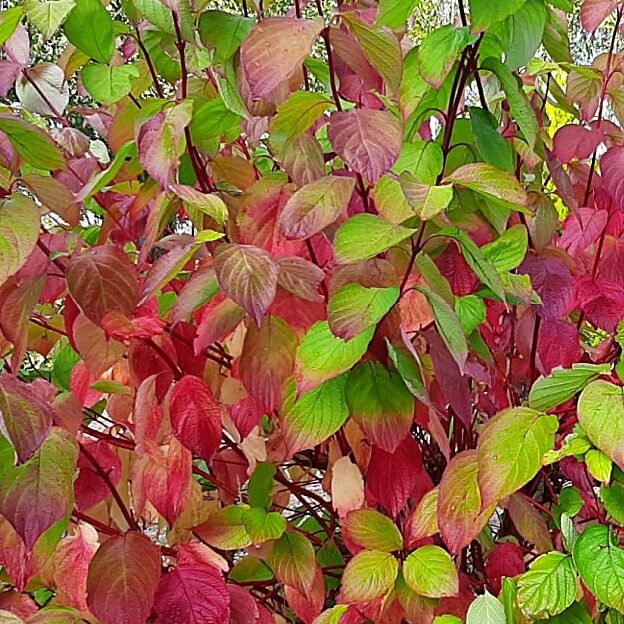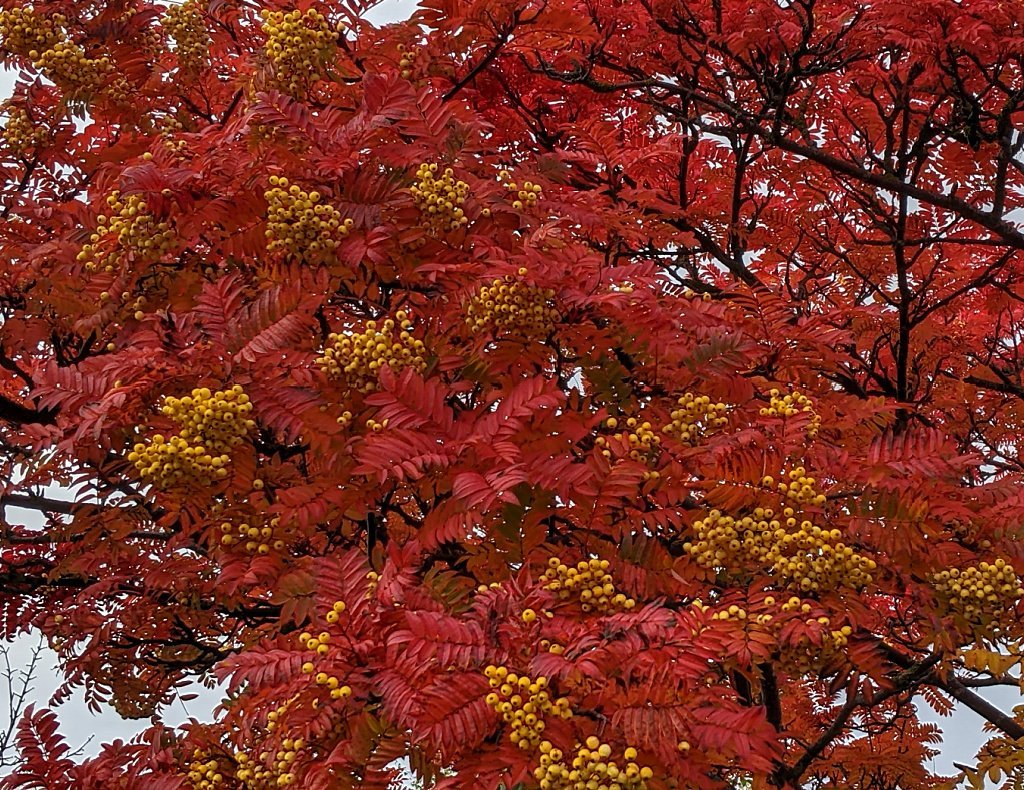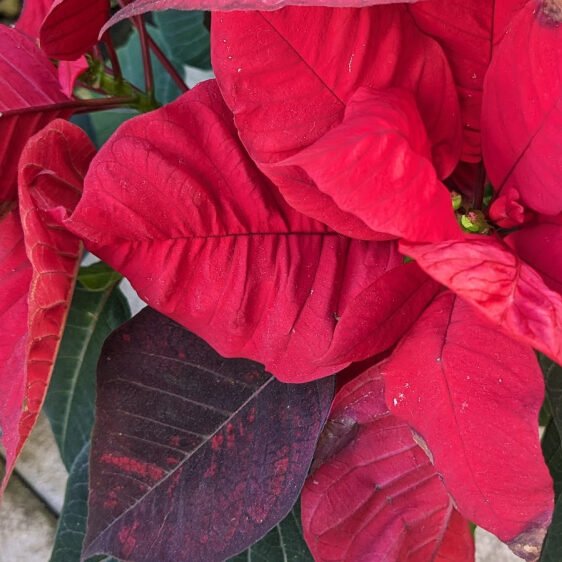Colour in the garden in the ending year
Season of mists and mellow fruitfulness, eh, in the autumn garden? Well, either you like autumn or you don’t. What does it mean to the gardener anyway? An excuse to go wild in the daffodil department, maybe. It’s still not too late to plant some in that empty corner, especially if you strike it lucky amongst the end of season bulb bargains.

You probably have missed getting your hyacinths in bloom for Christmas, if that sickly-sweet scent is something you like. To be honest, I do wonder if all this fuss to get bulbs out for the festive season is really worth it.
After all, what with the other decorations in the house, not to mention poinsettias and forced azaleas you see for sale, there is plenty of brightness indoors. It’s colour in the dim days of January and February we all need.
I’ll get on my hobby-horse about poinsettias further down the page.

‘Anticyclonic Gloom’
Anyway, I heard a rare phrase on the weather forecast the other week: ‘anticyclonic gloom’. It means those calm grey days when I swear you can hear the leaves fall off the trees. That’s when the autumn garden breeds its own kind of nostalgia – especially for the long, blazing days of summer we might have had.
But these calm days do mean the reds and yellow of the ending year at least hang around for longer before the westerly gales strip the trees bare.
I got a chance to wander round the plot and take note of what was still looking cheerful in the autumn garden. On the herbaceous front, things are decidedly off peak. The damp-loving Scrophularia aquatica ‘variegata’ still has plenty of colour.
This one gives good value if you can grow it on heavy, water-retaining soil. It’s a great foliage feature plant with its creamy margins and upright habit.
Buy it if you see it in garden centres – but give it plenty of space. It’s always sold in wee pots which give no indication of final size.
The other notable bright spot is a Sedum with the unsurprising name ‘Autumn Joy’ . It’s very reliable and keeps its mauve-red flower-heads shining out till late in the season.

Amongst the trees, one of the white-berried rowans (Sorbus hupehensis) has been the colour of flame for weeks now. Just one, though. The others, planted nearby at the same time and bought from the same nursery, have turned a dull orangey-green – attractive enough but hardly as vivid.
Hmm. What’s that about? This autumn colour thing isn’t that simple.
Certainly, the whole business of autumn colours is temperature related. The best years seem to have calm conditions to keep the leaves on longer, as well as low night time temperatures to trigger the colouring up process.
Wait, where do all the leaves go?
Unlike out in the wild-wood, there is the question of what to do with the leaves when they do end up on the lawn. (Oh, that’s such a middle-class problem!)
A very long time ago, I remember bagging up some leaves in a big black bin bag and leaving them beside the shed, hoping they would rot down for mulch. Well, they didn’t because they were too dry. You need to use wet leaves.

However, the bag was commandeered by a passing hedgehog who used it to raise a family. Obviously, I must have insecurely fastened the bag.
Not that I am recommending hedgehog-rearing as a use for autumn leaves. You could set up a hedgehog shelter though.
But before you throw them out or burn them (the leaves, I mean – bad idea, anyway), remember that as many as possible, one way or another, should go back to the soil from where they came.
Whether you let worms and other creepy crawlies do the job, or whether you want to compost the leaves depends on how tidy you feel in the autumn garden. It’s certainly a near-obsession for the over-tidy minded at this time of year.
Poinsettias – the temperamental Christmas decoration
As you gradually withdraw from the autumn garden as it gives way to deep winter, at the same time from the poshest High Street chain store to the wee corner shop, poinsettias for Christmas rear their red heads.
With their bracts colouring up a cheery hue in the dead of winter, they have become strongly associated with the festive season. They just look, well, festive, like some kind of non-jaggy holly in a pot.
This native of Mexico and tropical America has a proper name Euphorbia pulcherrima, though the more usual name poinsettia recalls Joel Roberts Poinsett (1779-1851) US Secretary of War and American Minister to Mexico who raised the plant from Mexican stock. (You never know, you might need this sort of thing in a virtual pub quiz or something.)
However, the question that everybody wants answered is ‘After Christmas, whit do ye dae wi them for the rest of the year?’
Ask me about the azalea hybrids that are also forced into flower for Christmas and I would tell you they are dead easy.
Keep them moist and well lit, then, when the last frosts are passed, feed them and plunge them, pot and all, into a shady, damp spot in the garden. Do not let them dry out. For plunging, a clay pot is probably best.
Then dig them up again – pot and all, of course – towards the end of September and, with a bit of luck, you’ll have them in flower again for the next Christmas. This can go on, year after year. Easy, eh?
But poinsettias? Ah well, they’re a bit different. Wait till you hear what you have to do with them if you want them to colour up for the next Christmas. It’s pretty crazy.
First of all, cut them back in the spring. Put them in a greenhouse for the summer, if you have one. Feed them and keep them in good light. That way you’ll have fresh green growth.
You can even take cuttings from them, if you insist on multiplying the awkward so and sos.

Poinsettia flowers themselves are wee insignificant greeny things. It’s the leaves round the flowers, called bracts, that colour up.
If your plant survives the summer, you will have a green poinsettia. Your challenge is to persuade the bracts to turn red again.
Alternatively, you could cheat. Cut leaf shapes out of red paper and wire them to the stems. If this sounds like swikkin (Scots: cheating), then, yes, it is! But it is better than trying to paint the leaves with red food colouring.
That definitely doesn’t work. It’s a bit sad really but I tried it once. What an admission for a gardener.
If you absolutely insist on trying to coax your poinsettia back into flower – and I’m doing my very best to put you off the whole idea – then daylight length is critical. From around the end of September onwards total darkness at night is essential. Cover it with a lightproof hood or bag for 14 hours every day. No, really.
Apparently, even a street light shining on them can upset them. You have to keep this up for eight weeks. It is at this point I ask you is it really worth it when they are under a tenner in the shops?
Besides, as commercially grown poinsettias are treated with a dwarfing chemical, the one you grow yourself will be spindly.
Finally, if I haven’t given you a complete scunner, there is the problem of the leaves dropping. Some folk have only to look at a poinsettia for it to turn completely bald, apart from the red bits at the top. Poinsettias seem to be sensitive wee souls.
The trouble with them is that they like it steady and warm with plenty of light from a south facing window. Expose them to hot or cold draughts and they sulk. They also like it moist as well, so you are advised to mist the leaves. In other words, the mantelpiece isn’t ideal.
At the end of the day, poinsettias look good but unless you are a dedicated gardener or tending towards the obsessive, you might as well treat them like a long lasting cut flower. Add them to the compost heap after the festivities are over. Or buy an azalea.
All about roses – let’s look forward to summer.
